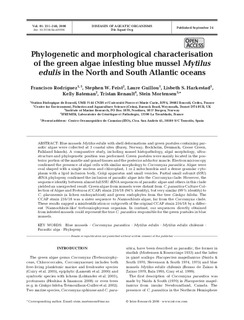| dc.description.abstract | Blue mussels Mytilus edulis with shell deformations and green pustules containing parasitic
algae were collected at 3 coastal sites (Burøy, Norway; Bockholm, Denmark; Goose Green,
Falkland Islands). A comparative study, including mussel histopathology, algal morphology, ultrastructure
and phylogenetic position was performed. Green pustules were mainly located in the posterior
portion of the mantle and gonad tissues and the posterior adductor muscle. Electron microscopy
confirmed the presence of algal cells with similar morphology to Coccomyxa parasitica. Algae were
oval shaped with a single nucleus and chloroplast, 1 or 2 mitochondria and a dense granular cytoplasm
with a lipid inclusion body, Golgi apparatus and small vesicles. Partial small subunit (SSU)
rRNA phylogeny confirmed the inclusion of parasitic algae into the Coccomyxa clade. However, the
sequence identity between almost full SSU rRNA sequences of parasitic algae and others in this clade
yielded an unexpected result. Green algae from mussels were distant from C. parasitica Culture Collection
of Algae and Protozoa (CCAP) strain 216/18 (94% identity), but very similar (99% identity) to
C. glaronensis (a lichen endosymbiont) and green endophytes from the tree Ginkgo biloba. The
CCAP strain 216/18 was a sister sequence to Nannochloris algae, far from the Coccomyxa clade.
These results suggest a misidentification or outgrowth of the original CCAP strain 216/18 by a different
‘Nannochloris-like’ trebouxiophycean organism. In contrast, our sequences directly obtained
from infested mussels could represent the true C. parasitica responsible for the green pustules in blue
mussels. | no_NO |
